12 General District Wide Matters
12.7-NOISE NOISE
Issues
District plan noise rules must recognise that virtually all activities produce some noise, and there is a need to provide a balance between the noise producer and the noise receiver. Noise and vibration are directly linked, and vibration standards are also found in this chapter.
The New Zealand Standards regarding noise cover the main source of noise experienced by communities and has been developed in line with other international equivalents and is considered best practice.
The plan’s rules for TCZ, COMZ and GIZ zones contain requirements for residential units in these zones to be acoustically insulated against intrusive noise from external sources. This is to help avoid complaints from future residents about business activities inhibiting otherwise legitimate activity in such zones.
Noise control boundaries have been calculated around the District’s hydroelectric power generating infrastructure on the Waikato River and the key industrial sites at Kinleith, Lichfield and Tīrau. This approach gives certainty to the surrounding residents about future noise levels, and flexibility to the industrial operator in planning future development and alterations. Acoustic insulation will also be required for residential buildings inside these control boundaries, to recognise the higher than usual noise levels and give the residents concerned an adequate standard of amenity.
A number of activities have been identified as requiring exemption from the standard noise limits, often because they vary widely throughout the year and are temporary and transient. Strict compliance with standard noise rules may not be practicable, reasonable or enforceable. Such activities are required to comply with alternative noise limits specified in Table 12.
The current and projected aircraft use at the airport is insufficient to justify applying the measures suggested in NZ Standard 6805 (Airport Noise Management and Land Use Planning). This standard recommends setting an air noise boundary to limit aircraft noise, and limits on residential and other sensitive development occurring within projected noise contours. Use of the Tokoroa Airport will be monitored, to see whether implementation of NZS6805 can be justified in the future.
Objectives
NOISE-O1
To ensure that new development mitigates adverse effects and provides for the health, safety and wellbeing of people and communities.
NOISE-O2
To provide for the sustainable, secure and efficient use and development of infrastructure within the District, while seeking to avoid, remedy or mitigate adverse effects on the environment recognising the technical, locational and operational requirements and constraints of the infrastructure concerned.
NOISE-O3
To provide for mineral exploration, mining and quarrying (including use of those resources by associated industries) and new network utility and infrastructure developments, that avoid, remedy or mitigate adverse effects on existing neighbouring land uses and amenity values, while recognising that the location of these activities is often fixed and dependent upon the location of the resources.
Policies
NOISE-P1
Avoid, remedy or mitigate the adverse effects of activities on the existing character and amenity values of the surrounding rural area and avoid those activities that would cause reverse sensitivity concerns for established rural based activities (including existing network utilities and infrastructure).
NOISE-P2
To minimise the potential for adverse effects of rural residential subdivision, use and development at the interface of the GRUZ and RLZ with other zones.
NOISE-P3
Enable the efficient operation and development of the District’s key industrial sites in a manner that will avoid, remedy or mitigate adverse effects on the environment from activities associated with the operation, maintenance, and upgrading of these key industrial sites.
NOISE-P4
Protect the safety and efficiency of the land transport network from the adverse effects of inappropriate noise-sensitive activities located close to State Highways and designated rail corridors.
NOISE-P5
Enable home businesses and a range of non-residential activities in residential areas where the effects of these businesses are consistent with maintaining the character and amenity values of the residential neighbourhoods.
NOISE-P6
Enable infrastructure development where the associated effects are avoided, remedied or mitigated and the functional requirements of the developer and operator of the network utilities and infrastructure are considered.
NOISE Standards
NOISE-R1 Zone-Based Noise limits
Noise from any activity (but excluding those listed in Table 12-Specific Activity Noise Limits) shall not exceed the following limits in Table 11 when measured at or within the following receiving zones:
Table 11 – Zoned Based Noise Limits | |||
|
Noise Limits, dB |
| |
Proposed Receiving Zone |
Daytime |
Night-time |
Notes |
|
On any day: |
At all other times: |
|
GRZ MU- SETZ |
50dB LAeq |
40dB LAeq |
|
GRUZ and RLZ |
50dB LAeq |
40dB LAeq |
To be measured and assessed within the notional boundary |
NCZ |
55dB LAeq |
45dB LAeq |
|
TCZ
|
60dB LAeq |
55dB LAeq |
- Octave band noise levels should not exceed: |
COMZ
|
65dB LAeq |
60dB LAeq |
Octave band noise levels should not exceed: |
GIZ and SPZ-ELG |
75dB LAeq |
70dB LAeq |
|
NOISE-R2 Specific Activity Noise limits
Table 12 – Specific Activity Noise Limits | ||||||
Activity |
Noise Controls | |||||
Construction Noise |
Comply with the provisions of NZS6803:1999 – Construction Noise | |||||
Temporary Activities,
|
At or within receiving zones |
L0, dB |
LAF(max), dB | |||
Temporary Film Making Activities |
0630-0730hrs 0730-1800hrs 1800-2000hrs 2000-0630hrs |
60 75 70 40 |
70 90 85 60 | |||
Vehicles and mobile machinery associated with rural production |
Exempt providing they are of limited duration and not in a fixed location and are vehicles and mobile machinery associated with rural production activities and S16 and S17 of the RMA have been satisfied. Examples include farm and forestry harvesting, spraying and planting machinery. | |||||
Mineral exploration, mining and quarrying |
Shall comply with the relevant zone noise limits at the specified measurement and assessment position for those zone(s), except that blasting noise and all vibration shall comply with the following: (a) Occur only between 7am and 7pm; and (b) No more than 2 events per hour, with a maximum of 8 events per day; and (c) Overblast pressure incident on residential units or habitable buildings (but excluding residential units or habitable buildings within the property containing the mine or quarry) shall not exceed 115dB LZpeak; and (d) Ground borne vibration shall not exceed the limits specified in DIN4150-2:1999 and Part 3:1999. | |||||
Community Events |
(a) Events held between 7am and 10.30pm, where the event and pre event rehearsal do not individually exceed 3 hours in duration, shall not exceed a noise limit of 80dB LAeq(1 hour) within relevant adjacent zone(s). Octave band noise levels at residential units or habitable buildings shall not exceed: 95dB LAeq (1 minute) at 63Hz 85dB LAeq (1 minute) at 125Hz (b) Events that do not meet the duration or hours specified in 1 above, but do not exceed 12 hours per day over a two-day period shall not exceed a noise limit of 70dB LAeq (1 hour) within relevant adjacent zone(s). Octave band noise levels at residential units or habitable buildings shall not exceed: 85dB LAeq (1 minute) at 63Hz 75dB LAeq (1 minute) at 125Hz (c) Events that do not meet the duration or hours specified in 1 or 2 above shall comply with the zone noise limits at the specified measurement and assessment position for those zone(s). | |||||
Helicopters |
Shall comply with the provisions of NZS6807:1994 – Noise Management and Land Use Planning for Helicopter Landing Areas. | |||||
Wind turbine generators with swept area greater than 80m2 |
Shall comply with NZS 6808: 2010 Acoustics – Wind farm noise | |||||
Audible bird scaring devices |
Noise from audible explosive bird scaring devices shall only be operated between sunrise and sunset, and shall not exceed 100dB LZpeak, when measured within the notional boundary of any GRUZ site, or within the site boundary of any GRZ site. Discrete sound events of a bird scaring device including shots or audible sound shall not exceed 3 events within a 1-minute period and shall be limited to a total of 12 individual events per hour. Where audible sound is used over a short or variable time duration, no event may result in a noise level greater than 50dB SEL when assessed at the notional boundary of any GRUZ site, or within the site boundary of any GRZ site. A legible notice is fixed to the road frontage of the property on which is the device is being used, giving the name, address and telephone number of the person responsible for the operation of any such device(s). | |||||
Residential units / occupancies/ habitable spaces in zones other than GRZ and GRUZ |
A residential unit or occupancy or habitable space is permitted in zones other than GRZ and GRUZ if the total internal noise level in any habitable room does not exceed 35dB LAeq (24 hours) while at the same time complying with the ventilation requirements of clause G4 of the New Zealand Building Code. The total noise level shall include all intrusive noise and mechanical services. In determining the external noise level, an assumption that the noise incident upon the noise sensitive facade is from at least three separate activities simultaneously generating the maximum allowable noise level for that zone. Compliance with the above must be confirmed in writing by a suitably qualified and experienced acoustic consultant. | |||||
Frost fans |
Noise generated by frost fans shall not exceed 55dB LAeq (15min) when assessed within the notional boundary of any other GRUZ site, or within the site boundary of any GRZ site. A legible notice is fixed to the road frontage of the property on which it is being used, giving the name, address and telephone number of the person responsible for its operation. | |||||
Atiamuri, Whakamaru, Maraetai, Waipapa, and Arapuni Electricity Generation Core Sites |
Noise from these sites shall not exceed 45dB LAeq (15min) when measured at the relevant noise control boundary shown in Figs 3 to 7. The noise limits shall not apply to sirens, circuit breakers and hydro spills associated with the Electricity Generation Core Sites. | |||||
Well drilling within Electricity Generation Core Sites |
Noise from drilling activities for the purpose of observation wells within Electricity Generation Core Site shall not exceed the following limits, for up to 30 days, when measured within the notional boundary of any GRUZ site or within the site boundary of any GRZ site: | |||||
Hours |
LAeq dB |
LAF(max), dB | ||||
0700-2200 |
70 |
85 | ||||
2200-0700 |
60 |
75 | ||||
Kinleith Industrial Sites, and Lichfield and Tīrau Dairy Factory Sites |
Noise from these sites shall not exceed 45dB LAeq (15 minutes) when measured at the relevant noise control boundary shown in Figs 8 to 10.
| |||||
Emergency response |
Exempt providing activity is in response to an emergency. All non-emergency related activities shall comply with the relevant zone standards. | |||||
Temporary military exercises undertaken without weapons firing |
Within the notional boundary to any building housing a noise sensitive activity |
LAeq dB |
LAF(max)dB | |||
0630-0730hrs |
60 |
70 | ||||
0730-1800hrs |
75 |
90 | ||||
1800-2000hrs |
70 |
85 | ||||
2000-0630hrs |
40 |
60 | ||||
Temporary military exercises undertaken with weapons firing and/or the use of explosives |
(a) Notice is provided to the Council at least 48 hours prior to the commencement of the activity, specifying whether the activity involves live firing and/or the use of explosives, or firing of blank ammunition; the location of the activity and the boundaries within which the activity will take place, and distances to buildings housing noise sensitive activities; and the timing and duration of the activity. | |||||
(b) Compliance with the noise standards below: | ||||||
|
Time (Monday to Sunday) |
Separation distance required between the point of firing and the notional boundary to any building housing a noise sensitive activity | ||||
Live firing of weapons and/or use of explosives |
0700-1900hrs |
At least 1500m |
Less than 1500m if conditions a) and c) below are complied with | |||
1900-0700hrs |
At least 4500m |
Less than 4500m if conditions b) and c) below are complied with | ||||
Firing of blank ammunition |
0700-1900hrs |
At least 750m |
Less than 750m if conditions a) and c) below are complied with | |||
1900-0700hrs |
At least 2250m |
Less than 2250m if conditions b) and c) below are complied with | ||||
Conditions to be complied with if minimum separation distances for temporary military exercises undertaken with weapons firing and/or the use of explosives cannot be met: | ||||||
Condition |
Time (Monday to Sunday) |
Noise level at the notional boundary to any building housing a noise sensitive activity | ||||
(a) |
0700-1900hrs |
Peak sound pressure level of 120 dBC | ||||
(b) |
1900-0700hrs |
Peak sound pressure level of 90 dBC | ||||
(c) |
The activity is undertaken in accordance with a Noise Management Plan prepared by a suitably qualified expert and provided to Council at least 15 working days prior to the activity taking place. The Noise Management Plan shall, as a minimum, contain: (i) A description of the site and activity including times, dates, and nature and location of the proposed training activities. (ii) Methods to minimise the noise disturbance at noise sensitive receiver sites such as selection of location, orientation, timing of noisy activities to limit noise received at sensitive receiver sites. (iii) A map showing potentially affected sites on which noise sensitive activities are based and predicted peak sound pressure levels for each of these locations. (iv) A programme for notification and communication with the occupiers of affected sites on which noise sensitive activities are located prior to the activities commencing, including updates during the event. (v) A method for following up any complaints received during or after the event, and any proposed de-briefing meetings with Council. | |||||
NOISE-R3 Internal Design Sound Levels
Buildings for noise sensitive activities sited:
- within a noise control boundary shown in Figs 3 to 10, or
- located within 80m (measured from the nearest painted edge of the carriageway) of a State Highway in an area with a 100km/h speed limit, or
- located within 80m of land that is subject to a notice of requirement for a State Highway (refer to Designations chapter),
shall be constructed to comply with the following standards in Table 13:
Table 13 – Internal Design Sound Levels | ||
Internal Design Sound Levels (based on AS/NZ 2107:2000 Recommended design levels and reverberation times for building interiors) | ||
Type of occupancy/activity |
Recommended Internal Design Sound Levels dB LAeq(24hour) | |
|
Satisfactory |
Maximum |
Residential Buildings - Bedrooms - Other habitable rooms |
35 (see note) 40 (see note) |
40 45 |
Visitor Accommodation - Bedrooms |
35 |
40 |
Community facility, educational facilities, health and veterinary services |
35 |
45 |
Educational Buildings (Teaching spaces) |
35 |
45 |
Office buildings (general office space) |
40 |
45 |
Compliance with Table 13 shall be confirmed in writing by a suitably qualified and experienced acoustic consultant.
Note: AS/NZ 2107:2000 recommends 30dB LAeq,t as the satisfactory internal design sound level for bedrooms, but the standard does not provide the time base (t) over which this occurs. Requiring compliance with 30dBA day and night may be technically difficult and costly to achieve in high-noise areas. Compliance with 35 dBA LAeq(24hr) is considered appropriate to protect amenity values because it considers the daytime and night time in totality.
Noise Control Boundary – Figure Three, Atiamuri
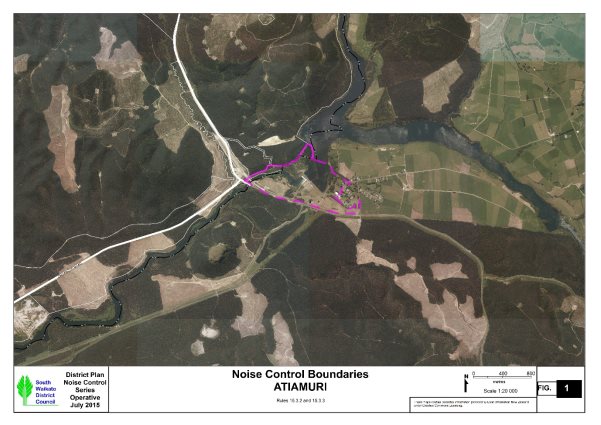
Noise Control Boundary – Figure Four, Whakamaru
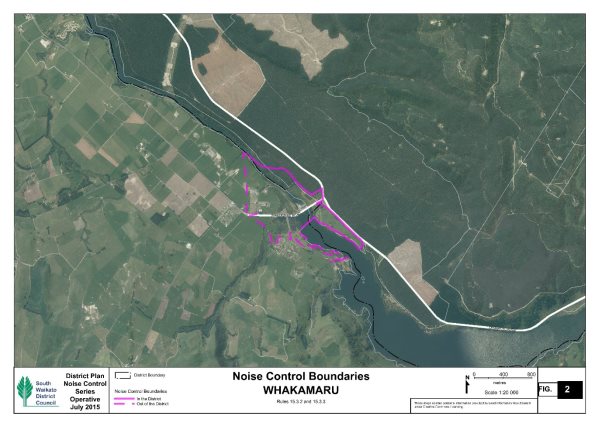
Noise Control Boundary – Figure Five, Maraetai
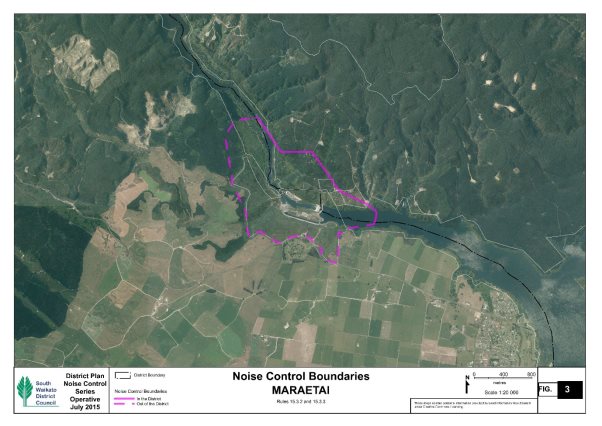
Noise Control Boundary – Figure Six, Waipapa
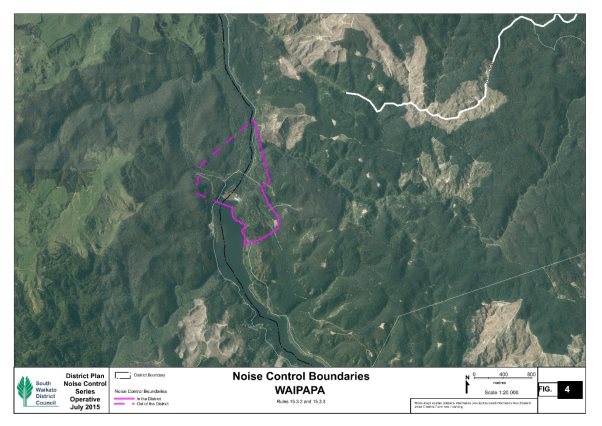
Noise Control Boundary – Figure Seven, Arapuni
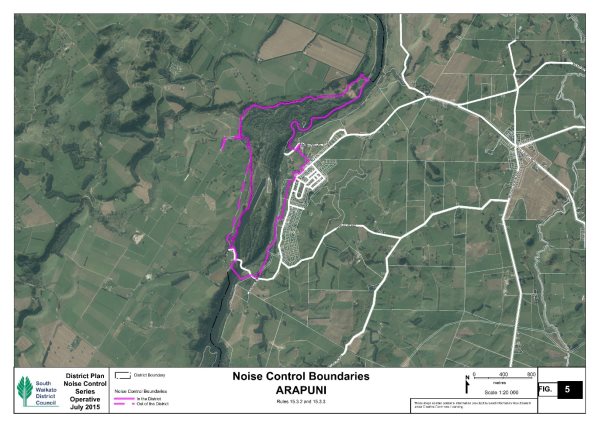
Noise Control Boundary – Figure Eight, Kinleith

Noise Control Boundary – Figure Nine, Lichfield
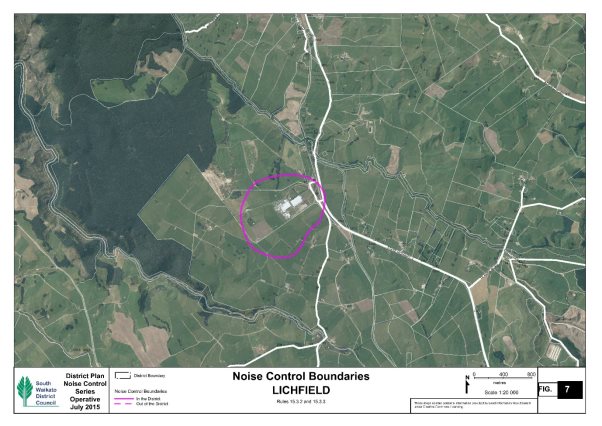
Noise Control Boundary – Figure Ten, Tirau
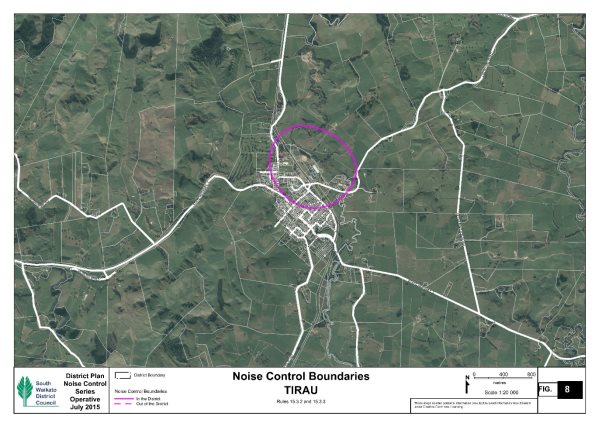
NOISE-R4 Internal Design levels for TCZ
(1) PREC1- Putaruru and PREC3-Tokoroa
Residential activity above ground floor level – The total internal noise level in any habitable room shall not exceed 35dB LAeq(24 hours) while at the same time complying with the ventilation requirements of Clause G4 of the NZ Building Code. The total noise level shall include all intrusive noise and mechanical services.
In determining the external noise level, it shall be assumed that the noise incident upon the noise-sensitive facade is from at least three separate activities simultaneously generating the maximum allowable noise level for that zone.
(2) PREC2-Tirau
Visitors’ accommodation or Residential activity at first floor level – The total internal noise level in any habitable room shall not exceed 35dB LAeq(24 hours) while at the same time complying with the ventilation requirements of Clause G4 of the NZ Building Code. The total noise level shall include all intrusive noise and mechanical services.
In determining the external noise level, an assumption that the noise incident upon the noise-sensitive facade is from at least three separate activities simultaneously generating the maximum allowable noise level for that zone.
NOISE-R5 Internal Design Sound Levels for Putaruru Urban Growth Cells 1 to 4 – Railway Activities
Noise Sensitive Activities within Putaruru Urban Growth Cells 1 to 4 located within 100m of a Rail Network Boundary shall meet Rule NOISE-R5(1) below:
NOISE-R5(1) Indoor railway noise
(a) Any new building or alteration to an existing building that contains an activity sensitive to noise:
(i) Shall be designed, constructed and maintained to achieve design noise levels resulting from the railway that do not exceed the maximum values in Table 14;
Table 14– Internal Noise Limits | ||
Building Type |
Occupancy/activity |
Maximum railway noise level, dB LAeq(1h) |
Residential |
Sleeping spaces |
35 |
|
All other habitable spaces |
40 |
Education |
Lecture rooms/theatres, music studios, assembly halls |
35 |
|
Teaching areas, conference rooms, drama studios, sleeping areas |
35 |
|
Libraries |
45 |
Health |
Overnight medical care wards |
40 |
|
Clinics, consulting rooms, theatres, nurses’ stations |
45 |
|
Places of worship, marae |
35 |
(b) Mechanical ventilation
If windows must be closed to achieve the design noise levels in clause (a)(i), the building shall be designed, constructed and maintained with a mechanical ventilation system that:
(i) For habitable rooms for a residential activity, achieves the following requirements:
- provides mechanical ventilation to satisfy clause G4 of the New Zealand Building Code; and
- is adjustable by the occupant to control the ventilation rate in increments up to a high air flow setting that provides at least 6 air changes per hour; and
- provides relief for equivalent volumes of spill air;
- provides cooling and heating that is controllable by the occupant and can maintain the inside temperature between 18°C and 25°C; and does not generate more than 35 dB LAeq(30s) when measured 1-metre away from any grille or diffuser
(ii) For other spaces, is as determined by a suitably qualified and experienced person.
NOISE-R5(2) Acoustic Report
A report shall be prepared by a suitably qualified and experienced acoustic consultant and submitted to the council demonstrating compliance with NOISE-R5(1) above (as relevant) prior to the construction or alteration of any building containing an activity sensitive to noise. In thedesign:
(a) Railway noise is assumed to be 70 LAeq(1h) at a distance of 12 metres from the track, and must be deemed to reduce at a rate of 3 dB per doubling of distance up to 40 metres and 6 dB per doubling of distance beyond 40 metres;
(b) Railway noise spectrum at 12 m shall be assumed to be:
Octave Band Centre Frequency (Hz) | |||||||
63 |
125 |
250 |
500 |
1000 |
2000 |
4000 |
dBA |
78 |
72 |
69 |
66 |
66 |
63 |
58 |
70 |
NOISE-R6(1) Measurement and Assessment
(a) Noise shall be measured and assessed using the following standards:
- NZS 6801:2008 Acoustics – Measurement of Environmental Sound
- NZS 6802:2008 Acoustics – Environmental Noise
- NZS 6803:1999 Acoustics – Construction Noise
- NZS 6805:1992 Airport Noise Management and Land Use Planning
- NZS 6806: 2010 Acoustics – Road traffic Noise: New and altered roads
- NZS 6807:1994 Noise Management and Land Use Planning for Helicopter Landing Areas
- NZS 6808: 2010 Acoustics – Wind farm noise
(b) Noise levels shall be measured and assessed in accordance with the relevant Standard(s).
(c) Where a scenario arises where the standards above are not best suited in assessing the noise source or receiver of interest, Council may through the resource consent process agree to the use of alternative standards.
NOISE-R6(2) Alternative Noise Measurement Position
Alternative measurement location(s) to those specified above may be appropriate where acoustic standards suggest an alternative measurement location, or on a case-by-case basis as may be agreed through the resource consent process. This shall be discussed and agreed with appropriate Council staff. Any reports submitted to Council shall describe the use of an alternative measurement position and the reasons for its use.
NOISE-R6(3) Measurement and Assessment - Vibration
(a) Vibration from any activity (excluding mineral exploration, mining and quarrying, as specifically provided for in NOISE-R2 Table 12, shall be measured and assessed in accordance with the following standards:
- AS 2670.1-2001 Evaluation of human exposure to whole-body vibration – General requirements
- AS 2670.2-1990 Evaluation of human exposure to whole-body vibration - Continuous and shock-induced vibration in buildings (1 to 80 Hz)
- DIN 4150-3:1999 Effects of vibration on structures
(b) Where a scenario arises where the standards above are not best suited in assessing the vibration source or receiver of interest, Council may through the resource consent process agree to the use of alternative standards.
NOISE-R6(4) Matters of Discretion
(a) For resource consent for activities that are not predicted to comply with the relevant zone noise controls, including activities on the surface of water, the matters in respect of which Council has restricted its discretion are:
(i) The maximum level of noise to be generated, and its nature, character and frequency, in relation to the disturbance this may cause to people in the vicinity
(ii) The length of time for which specified noise levels will be exceeded, particularly at night, with regard to likely disturbance that may be caused
(iii) The extent to which it is practicable to require acoustic shielding and other mitigation measures to achieve the relevant noise limits. This includes possible noise insulation of habitable buildings on other sites
(iv) The impact of noise from surface water activities on wildlife in the area, including the timing of noise in relation to life cycle stages during which wildlife are more vulnerable to disturbance (e.g. nesting seasons).
NOISE-R7 Other Plan Matters
The following may also be relevant:
(1) Section 7.1 Energy, 7.2 Infrastructure, 7.3 Transportation
(2) Section 8.1 Contaminated Land, 8.2 Hazardous Substances, 8.3 Natural Hazards
(3) Section 9.1 Historic Heritage, 9.2 Sites and Areas of Significance to Māori
(4) Section 10.1 Ecosystems and Indigenous Biodiversity, 10.2 Natural Character, 10.3 Natural Features and Landscapes, 10.4 Public Access
(5) Chapter 11 Subdivision
(6) Section 12.1 All Activities
(7) Section 12.2 Activities on the Surface of Water, 12.3 Air Emissions, 12.4 Earthworks, 12.6 Light, 12.8 Signs, 12.9 Temporary Activities
(8) Part 3- Any relevant zone or overlay
NOISE- Principal Reasons
NOISE-PR1
Historically, noise rules and New Zealand’s environmental noise standards have often been based upon existing noise levels in an area. This approach is now disappearing, as it is recognised that if there is to be development in an area, noise rules must provide an appropriate level of amenity for the developed area, whilst at the same time allowing noise generating activities to generate reasonable levels of noise. The assumption that new residential units and/or business can be introduced into an area and somehow still maintain a noise level consistent with an undeveloped area is generally impractical. The purpose of the district plan’s noise limits is to allow development while controlling noise to an appropriate level.
NOISE-PR2
The plan uses the “LAeq” descriptor for the assessment and measurement of environmental noise levels and for the specification of noise limits in district plans. “LAeq” is used in the most recent versions of all relevant environmental acoustic standards. It is the energy average of noise during a specified period and is commonly known as the average noise level. “LAFmax” controls are also used during night-time hours, to limit the short duration “peak” noise levels that are correlated with sleep disturbance.
NOISE- Anticipated Environmental Results
NOISE-AER1
COMZ and GIZ noise rules which allow intended activities to take place
NOISE-AER2
Safeguarding the amenity levels of GRZ, RLZ and GRUZ zones from intrusive noise, particularly at night.
NOISE-AER3
Avoiding reverse sensitivity issues arising from potentially noise sensitive activities such as residential units being developed in COMZ and GIZ, or near other noise generators.